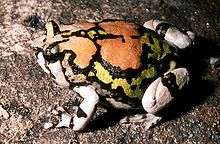Scaphiophryne gottlebei
| Rainbow Burrowing Frog | |
|---|---|
 | |
| Scientific classification | |
| Kingdom: | Animalia |
| Phylum: | Chordata |
| Class: | Amphibia |
| Order: | Anura |
| Family: | Microhylidae |
| Subfamily: | Microhylinae |
| Genus: | Scaphiophryne |
| Species: | Scaphiophryne gottlebei |
| Binomial name | |
| Scaphiophryne gottlebei Busse and Böhme, 1992 | |
Scaphiophryne gottlebei, commonly known as the Malagasy rainbow frog, the ornate hopper, the rainbow burrowing frog, the red rain frog or Gottlebe's narrow-mouthed frog, is one of the most highly decorated of the Madagascan frogs. Thousands are captured every year for the pet trade.[2]
Description
The Malagasy rainbow frog is a small, roundish, brightly coloured species with a distinctive white, red, green and black pattern on the back, each area of which is clearly delineated. The skin on the back is very smooth, but that of the grey belly is a little bit rough. The snout is rounded, the eyes are prominent but the tympani are inconspicuous. The limbs are short and robust and the digits of the hand have large tips and the hind feet are webbed. Adapted for both underground and climbing lifestyles, the Malagasy rainbow frog has horny tubercles on the underside of the hind feet to help with burrowing, and claws on the forefeet for clinging to vertical canyon walls. With a length of 30 to 40 mm (1.2 to 1.6 in), females are larger than males which only measure 20 to 30 mm (0.8 to 1.2 in).[3]
Distribution and habitat
The Malagasy rainbow frog is endemic to the central part of southern Madagascar and occurs in the Isalo Massif. It is present in the Isalo National Park where it is found in narrow canyons where the conditions are cool and humid. It digs burrows in the sandy areas bordering the streams and at night climbs on the rock walls.[3] It is also found in open rocky areas, mostly in dry forest.[1]
Behaviour
Breeding takes place after the start of the rainy season. Males call from rock walls or the surface of temporary pools and it is in these that the eggs are laid. The tadpoles have a stout oval body with flattened underside. They appear black in the daytime but turn brownish-grey at night. They are detrivores and have the unusual habit of spending the day with their heads submerged in the sediment at the bottom of the pool and their tails projecting at an angle. During the night the tadpoles swim around, probably filter feeding. Many tadpoles are swept away from by torrents during the rainy season and may complete their metamorphosis elsewhere.[3]
Status
The IUCN lists the Malagasy rainbow frog as "Endangered". Although it is quite common in some areas, it has a restricted range and its population is believed to be decreasing. The major threat it faces is collection for the pet trade. Other threats may include habitat degradation, timber extraction, wildfires and sapphire mining. It is a CITES Appendix II listed species.[1]
References
- 1 2 3 Franco Andreone; Christopher Raxworthy; Frank Glaw (2008). "Scaphiophryne gottlebei". IUCN Red List of Threatened Species. Version 2013.1. International Union for Conservation of Nature. Retrieved 2013-12-07.
- ↑ Behler, John L.; Deborah A. Behler (2005). Frogs: A Chorus of Colors. New York: Sterling Publishing Co., Inc. p. 121. ISBN 1-4027-2814-X.
- 1 2 3 Franco Andreone; Vincenzo Mercurio; Frank Glaw; Miguel Vences; Xi Zhai (2010-07-19). "Scaphiophryne gottlebei ". AmphibiaWeb. Retrieved 2013-12-07.
External links
| Wikimedia Commons has media related to Scaphiophryne gottlebei. |
- Arkive.org Painted Burrowing Frog
- Amphibian.co.uk Madagascan Burrowing Frogs
- Amhibianweb.org Scaphiophryne gottlebei
